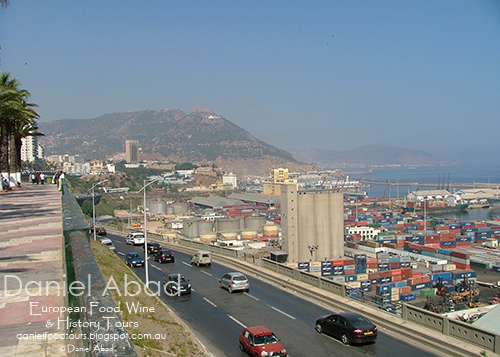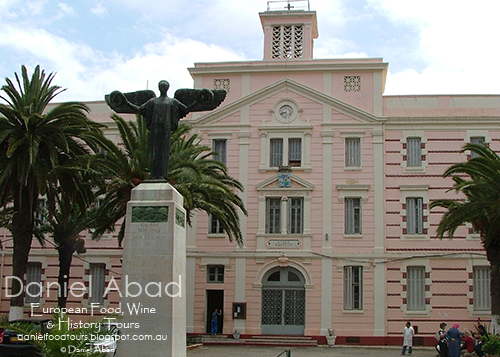Oran is a major city on the north-western Mediterranean coast
of Algeria, and the second largest city of the country. It is located 432 kilometres from the capital
Algiers. It is a major port and the commercial,
industrial, and educational centre of western Algeria. The city has a population of about a million
people and a regional population of approximately double that amount, making it
the second largest city in Algeria.
 |
| General View of Oran |
The name Oran comes from the Arabic word "Wahran" meaning two lions. The legend says that around the 10th century, there were still lions in the area. The last two lions were hunted at a mountain near Oran now called "La Montagne des Lions (Lions Mountain"; hence the presence of two lion statues outside the city hall in the Place du 1er Novembre.
 |
| The Lions' Mountain in the background |
 |
| The Lions at the Entrance of the City Council Building |
During the Roman Empire, the area of Oran was a small settlement, which disappeared after the Arab conquest of the Maghreb. Oran was founded in 903 by Andalusian merchants as a base for trade with the North African hinterland. It developed its commercial potential owing to its sea connections with Europe. It was captured by the Spanish in 1509 and that sovereignty lasted until 1708, when the city was conquered by the Ottomans. Spain recaptured the city in and sold it to the Turks in 1792. The Ottoman rule lasted until 1830, when it fell to the French.
The city is the setting for the French writer Albert Camus’ Novel’s novel “La Peste” (The Plague) written in 1947. Yves Saint Laurent was born there in 01 August 1936.
Oran's Opera House was built in 1908 and restored in 2008. It was modelled on the one in Paris and during the French occupation, it hosted some of the biggest French and foreign entertainment acts. Now as then, the opera has retained its function as the entertainment centre of the city and the region. Located on the Place du 1er novembre; formerly the Place d'armes, the opera has retained all its majesty. I was able to visit that place in 2014 and marvelled at its architecture and grandeur.
This is the high school where I studied for 5 years before leaving Algeria. Going back there brought back a lot of memories of my youth and all the friends I had made during those years. I have kept in touch with some but lost touch with most of them.
 |
| The City Council Building |
During the Roman Empire, the area of Oran was a small settlement, which disappeared after the Arab conquest of the Maghreb. Oran was founded in 903 by Andalusian merchants as a base for trade with the North African hinterland. It developed its commercial potential owing to its sea connections with Europe. It was captured by the Spanish in 1509 and that sovereignty lasted until 1708, when the city was conquered by the Ottomans. Spain recaptured the city in and sold it to the Turks in 1792. The Ottoman rule lasted until 1830, when it fell to the French.
During French rule, until 1962, Oran was the capital of the département of Oranie. Before the Algerian War, (1954–1962), Oran had one of the highest proportions of Europeans of any city in North Africa. Shortly after the end of the war, most of the Europeans living in Oran fled to France. In less than three months, Oran lost about half its population.
Oran was one of the principal objectives in the Allied landings in North Africa and was occupied by U.S. forces on 10 November 1942. At the time of the Algerian independence in 1962, Oran’s naval functions had gradually lapsed in favour of commercial ones.
 |
| The Famous "Boulevard Front de Mer" facing the Port of Oran |
 |
| The Commercial Port of Oran |
 |
| The Opera House in Oran |
 |
| Inside the Opera |
Another imposing building in Oran is the former cathedral; now the city's library. A number of churches in Algeria were reconverted to mosques after the 1962 independence but the Oran cathedral became a library instead because it was not facing in the direction of Mecca.
 |
| The Cathedral - Now a Library |
 |
| The High School I Attended |

No comments:
Post a Comment